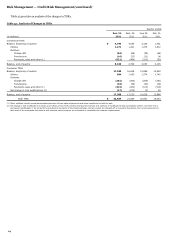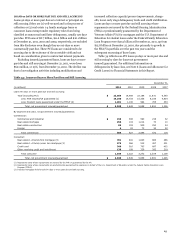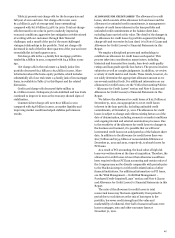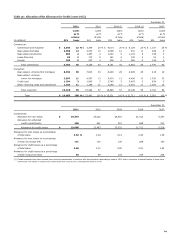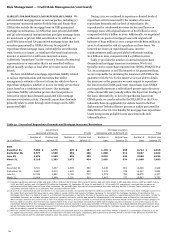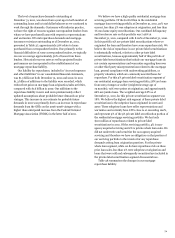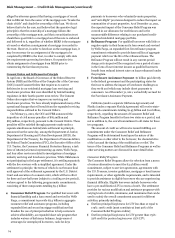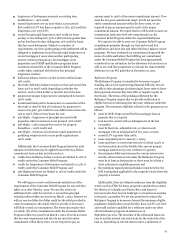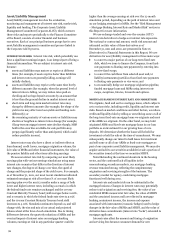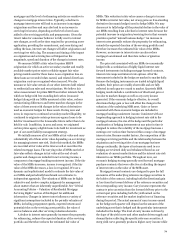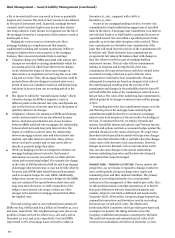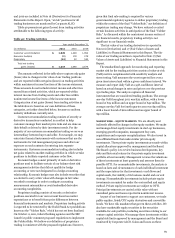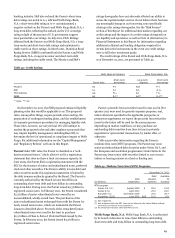Wells Fargo 2011 Annual Report Download - page 76
Download and view the complete annual report
Please find page 76 of the 2011 Wells Fargo annual report below. You can navigate through the pages in the report by either clicking on the pages listed below, or by using the keyword search tool below to find specific information within the annual report.
Risk Management — Credit Risk Management (continued)
alleged by attorneys general that having a mortgagee of record
that is different from the owner of the mortgage note “breaks the
chain of title” and clouds the ownership of the loan. We do not
believe that to be the case, and believe that the operative legal
principle is that the ownership of a mortgage follows the
ownership of the mortgage note, and that a securitization trust
should have good title to a mortgage loan if the note is endorsed
and delivered to it, regardless of whether MERS is the mortgagee
of record or whether an assignment of mortgage is recorded to
the trust. However, in order to foreclose on the mortgage loan, it
may be necessary for an assignment of the mortgage to be
completed by MERS to the trust, in order to comply with state
law requirements governing foreclosure. Our practice is to
obtain assignments of mortgages from MERS prior to
commencing the foreclosure process.
Consent Orders and Settlement in Principle
In April 2011, the Board of Governors of the Federal Reserve
System (FRB) and the Office of the Comptroller of the Currency
(OCC) issued Consent Orders that require us to correct
deficiencies in our residential mortgage loan servicing and
foreclosure practices that were identified by federal banking
regulators in their fourth quarter 2010 review. The Consent
Orders also require that we improve our servicing and
foreclosure practices. We have already implemented many of the
operational changes that will result from the expanded servicing
responsibilities outlined in the Consent Orders.
On February 9, 2012, the OCC and FRB announced the
imposition of civil money penalties of $83 million and
$85 million, respectively, pursuant to the Consent Orders. These
penalties will be satisfied through payments made under a
separate simultaneous federal/state settlement in principle,
announced on the same day, among the Department of Justice,
Department of Housing and Urban Development (HUD), the
Department of the Treasury, the Department of Veterans Affairs,
the Federal Trade Commission (FTC), the Executive Office of the
U.S. Trustee, the Consumer Financial Protection Bureau, a task
force of Attorneys General representing 49 states, Wells Fargo,
and four other servicers related to investigations of mortgage
industry servicing and foreclosure practices. While Oklahoma is
not participating in the larger settlement, it is settling separately
with the five servicers with a simplified agreement. Under the
settlement in principle, the terms of which do not become final
until approval of the settlement agreement by the U.S. District
Court and execution of a consent order, which will be in effect
for three and one-half years (subject to a trailing review period),
we have agreed to the following programmatic commitments,
consisting of three components totalling $5.3 billion:
Consumer Relief Program For qualified borrowers with
financial hardship and a loan owned and serviced by Wells
Fargo, a commitment to provide $3.4 billion in aggregate
consumer relief and assistance programs, including
expanded first and second mortgage modifications that
broaden the use of principal reduction to help customers
achieve affordability, an expanded short sale program that
includes waivers of deficiency balances, forgiveness of
arrearages for unemployed borrowers, cash-for-keys
payments to borrowers who voluntarily vacate properties,
and “anti-blight” provisions designed to reduce the impact on
communities of vacant properties. As of December 31, 2011,
the expected impact of the Consumer Relief Program was
covered in our allowance for credit losses and in the
nonaccretable difference relating to our purchased credit-
impaired residential mortgage portfolio.
Refinance Program For qualified borrowers with little or
negative equity in their home and a loan owned and serviced
by Wells Fargo, an expanded first-lien refinance program
commitment estimated to provide $900 million of aggregate
payment relief over the life of the refinanced loans. The
Refinance Program will not result in any current-period
charge as its impact will be recognized over a period of years
in the form of lower interest income as qualified borrowers
benefit from reduced interest rates on loans refinanced under
the program.
Foreclosure Assistance Payment $1 billion paid directly
to the federal government and the participating states for
their use to address the impact of foreclosure challenges as
they see fit and which may include direct payments to
consumers. As of December 31, 2011, we had fully accrued for
the Foreclosure Assistance Payment.
California (under a separate California Agreement) and
Florida (under a separate Florida Agreement) will receive state-
specific sub-commitments totaling $1.95 billion and $1.0 billion,
respectively, regarding the amount of Consumer Relief and
Refinance Program benefits for these two states as a part of, and
not in addition to, the overall commitment to all states for these
two programs.
The amount of credit we will receive toward fulfilling our
commitments under the Consumer Relief and Refinance
Programs will be determined based upon the nature of the
modification or other relief to the borrower, the characteristics
of the loan and the timing of the modification or relief. The
terms of the Consumer Relief and Refinance Programs as well as
other servicing matters are discussed in more detail below.
Consumer Relief Program
The Consumer Relief Program allows for selection from a menu
of various alternatives to meet the $3.4 billion overall
commitment, subject to servicer agreements, agreements with
the U.S. Treasury, investor guidelines, mortgage or bond insurer
requirements, or other applicable requirements, and is intended
to provide assistance to eligible borrowers who are experiencing
financial difficulty. Eligible borrowers include borrowers who
have a pre-modification LTV in excess of 100%. The settlement
provides for various modification and assistance programs with
varying levels of credits, minimums, and maximums that can be
used to satisfy the overall commitment amount for different
activities, primarily including:
first lien principal forgiveness for LTV less than or equal to
175%: 100% credit (must constitute at least 30% of the
Consumer Relief Program credits);
first lien principal forgiveness for LTV greater than 175%:
50% credit for portion forgiven over 175% LTV;
74


